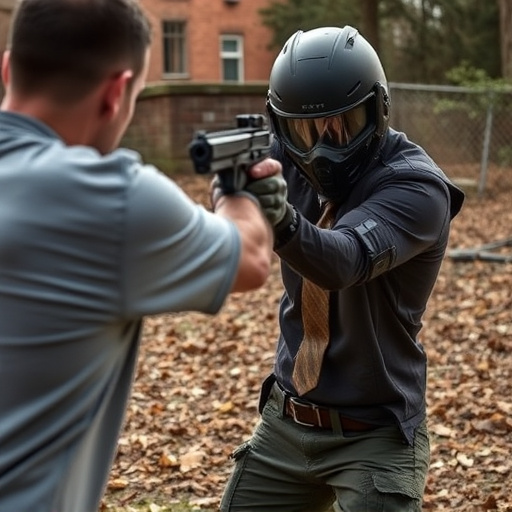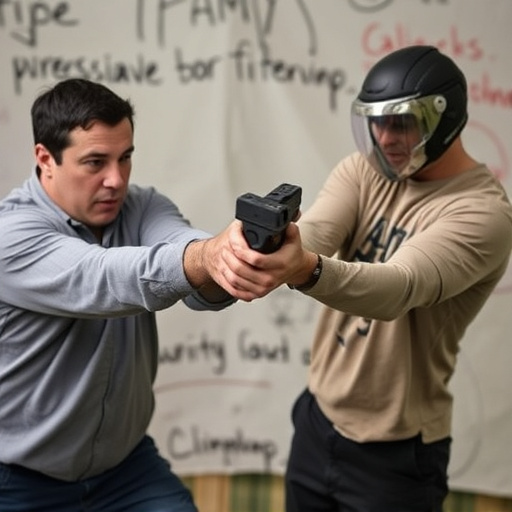Disguised stun guns serve as powerful yet discreet self-defense tools, appealing to those seeking protection without drawing attention. These devices disrupt neuromuscular transmission, causing temporary paralysis for 5-10 minutes, enabling users to escape or deter attackers. Legal regulations and safety precautions are crucial; proper training, maintenance, and adherence to local laws ensure reliable use. With compact designs blending into everyday items like flashlights or keychains, they offer a unique blend of discretion and protection in various scenarios, including late-night walks, property patrolling, and emergency situations.
“Unveiling the power of disguised stun guns as innovative self-defense tools, this article delves into their intricate workings and impact. From understanding the science behind muscle incapacitation to exploring the legal landscape, we demystify these devices. Discover how long their effects last and learn about their effectiveness in real-world scenarios.
We’ll guide you through the key considerations, ensuring a comprehensive view of disguised stun guns as viable personal safety options.”
- Understanding Stun Guns: Disguised Self-Defense Tools
- The Science Behind Muscle Incapacitation
- Duration of Effect: How Long Does It Last?
- Legal Considerations and Safety Precautions
- Effective Use Cases for Disguised Stun Guns
Understanding Stun Guns: Disguised Self-Defense Tools

Stun guns, also known as electronic control devices (ECDs), are powerful yet often discreet self-defense tools designed to incapacitate an assailant temporarily. These devices emit a high-voltage, low-current electrical pulse that disrupts the neural signals controlling muscle movement, leading to temporary muscle spasms and loss of balance in the targeted individual. The concept behind stun guns is to provide individuals with a non-lethal way to defend themselves against potential threats.
Disguised as everyday objects like flashlights or mobile power banks, stun guns offer an extra layer of security without drawing unnecessary attention. Their compact size and diverse design make them easily concealable, allowing users to carry them discreetly for peace of mind. This unique aspect sets stun guns apart from traditional self-defense weapons, making them appealing to individuals seeking effective yet concealed personal protection.
The Science Behind Muscle Incapacitation

The science behind muscle incapacitation from stun guns is a fascinating aspect of personal defense tools. When a stun gun delivers an electric shock, it disrupts the neuromuscular transmission in the body, leading to muscle contraction and temporary paralysis. This disruption prevents the brain from sending signals to the muscles, resulting in incapacitation. The duration of this effect varies based on factors such as the stun gun’s power output, the target’s size and strength, and their overall health.
Disguised stun guns, often designed for self-defense purposes, leverage this scientific principle. Their compact and unassuming appearance allows users to carry them discreetly, providing a sense of security. These tools are engineered to deliver a controlled electrical shock, ensuring the user has time to escape or deter an attacker before the effects wear off. Understanding the science behind muscle incapacitation is crucial for those considering stun guns as self-defense measures, enabling them to make informed decisions about their personal safety.
Duration of Effect: How Long Does It Last?

The duration of muscle incapacitation from a stun gun can vary significantly depending on various factors, including the device’s power output, the target’s size and physical condition, and their level of resistance. Typically, a stun gun’s primary effect is to disrupt muscular control, causing temporary paralysis or disorientation in the target. This disruption usually lasts for several minutes, rendering the individual immobile and vulnerable.
Disguised stun guns, often marketed as self-defense tools, are designed to provide users with a quick and effective means of deterring potential threats. While the exact duration may differ between models, most stun guns on the market deliver their full effect for around 5 to 10 minutes. This brief but intense period of incapacitation can be crucial in allowing the user to escape or seek help, making these devices valuable tools for personal safety.
Legal Considerations and Safety Precautions

When it comes to muscle incapacitation durations from stun guns, it’s crucial to understand the legal considerations and safety precautions surrounding their use. Disguised stun guns, often marketed as self-defense tools, are subject to various regulations that differ by region. Users must be aware of local laws to avoid legal repercussions. Some areas have strict restrictions on who can possess and carry stun devices, while others have specific requirements for activation and deactivation mechanisms.
Safety precautions are paramount when employing stun guns as self-defense tools. Proper training is essential to ensure effective and safe use. This includes understanding the range of effectiveness, the physical limitations of the device, and how to properly aim for maximum impact without causing unnecessary harm. Additionally, regular maintenance and testing of stun guns can help guarantee their reliability in critical situations.
Effective Use Cases for Disguised Stun Guns

Disguised stun guns offer a unique blend of functionality and discretion, making them potent self-defense tools for individuals seeking to protect themselves in various scenarios. Their compact design allows them to be easily hidden, whether carried as a fashion accessory or integrated into everyday items like pens or keychains. This subtlety is particularly advantageous in situations where drawing attention should be minimized, such as during personal protection or when patrolling properties.
Effective use cases for disguised stun guns include personal safety during late-night walks, self-defense against potential assailants, and even as a deterrent for burglars. Their non-lethal force can incapacitate attackers long enough for the user to escape or seek help, providing a crucial window of opportunity. Additionally, these devices are valuable tools for security professionals, concierges, and individuals working in remote areas where access to traditional law enforcement may be limited.
Stun guns, as disguised self-defense tools, offer a non-lethal means of incapacitating an attacker. Understanding their mechanism of action and the duration of muscle incapacitation they produce is crucial for effective deployment. This article has explored the science behind stun guns, their legal considerations, and safety precautions, providing insights into how these devices can be used responsibly and effectively in self-defense scenarios. Remember that proper training and a clear understanding of local laws are essential when considering armed self-defense with disguised stun guns.
